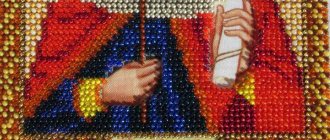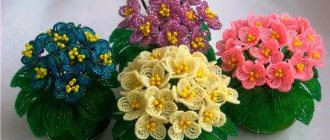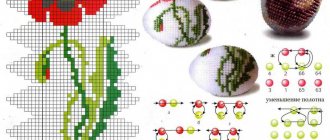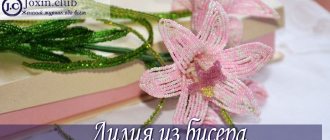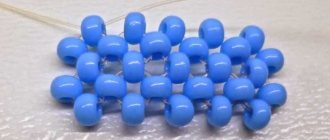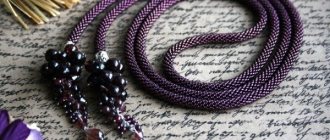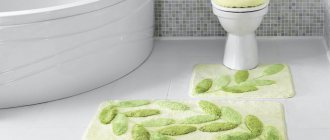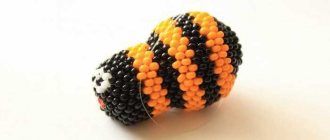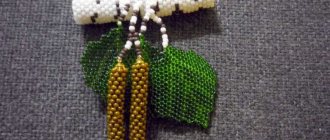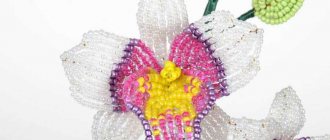I want to share my Easter egg making tutorial. For these purposes, it is better to use Czech beads, they are of higher quality. And blanks for eggs are made of foam or wood. I usually use wooden eggs.
You will also need a beading needle, glue, silk thread or fishing line. I would like to make an accent; I do not recommend using blanks made from ordinary chicken eggs, as they are fragile. Very easy to use, wooden ones.
I have made various jewelry from beads, but I have a master class on making eggs from beads for beginners. Following the rule, everything ingenious is simple. I made this Easter decoration in a couple of hours.
This is my work, look what a bright, burning, beautiful craft it turns out to be. Moreover, I didn’t select beads, I made them from what I had. A few years ago, I was embroidering icons with beads, I had leftovers, and I made some brooches and Easter decorations.
Color symbolism
It has been known for a long time and they try to stick to it.
- white - purity, sinlessness;
- blue - divine wisdom, element of air;
- red - love, health;
- yellow - sun, prosperity, protection;
- green - rebirth, life;
- brown - fertility;
- golden - light, strength;
- silver - cleansing;
The patterns are also significant: rhombuses - harmony, triangles - trinity, sigma - fertility, cross - the universe.
Before you get started, think about what your work of art will be about. Think over the motive, artistic solution, style.
Pasting eggs with beads
Pasting eggs with beads is the simplest and most straightforward method compared to braiding. Working with beads is very painstaking and requires a lot of time.
You will need: hard-boiled eggs, beads, PVA glue, toothpicks, food coloring, dry napkins, a simple pencil, thin fishing line or nylon threads.
Measure seven times
You can’t do without measurements and calculations. Braiding an egg with beads is a delicate and painstaking job, be patient. Using a measuring tape, measure the diameter of the egg “at the waist”, then its height. Match the parameters with the sample.
If they are different (for example, your workpiece is wider or lower), make an adjustment. To do this, calculate the number of beads per centimeter. For example, 4 beads No. 10 fit in 1 cm. Let's assume the girth of your workpiece is 15cm. Accordingly, we multiply 4 by 15, for a total of 60 pieces. will lie in a circle.
And in your pattern of an Easter egg made of beads there are 54 of them. Therefore, we will add 6. We will similarly adjust the height. It is important that the drawing is not damaged. Add beads in the background of the design or along the edges.
Beading pattern for eggs: mesh weaving
Material:
- Egg mockup
- Beads
- fishing line
- Needles
Progress:
- Place beads on the fishing line so that the diameter of the closed row coincides with the wide part of the egg. Select the number of beads that will be divisible by 6, there can be 36, 42, etc. To close the chain, you need to draw a needle and fishing line into the first bead.
- Then collect five beads, count the sixth one in the finished chain, and insert the needle into it. This will make a rhombus. Weave the remaining diamonds using the same principle, ending the row at the first bead.
- To weave the second row of diamonds, you need to pass the needle along the diamond with the exit through the third bead. String five beads onto a fishing line and insert the needle into the third bead of the adjacent diamond. In the same way, create the remaining grids of diamonds that will braid the middle of the egg.
- Place the finished belt on the egg blank and braid the tapering parts. Now continue as you did before, but instead of five beads, place three beads each. As the diameter decreases, you will take one bead at a time towards the end.
If you are a beginner, we do not recommend taking on complex schemes. Plan your time to get there in time for the holiday, as the process may not be quick. Beading requires perseverance, good eyesight and attentiveness. Study the diagrams carefully to please yourself with beautiful interior decorations for the holidays.
How to braid an egg with beads for a beginner
For those who are weaving for the first time, it is better to start with spirals. Take a metallized thread 1.5-2m long. String beads onto it. Apply PVA glue to the workpiece. Secure the end to the top of the egg, carefully wind the thread in a spiral. Make sure that the beads fit tightly to each other and that there are no gaps between the tiers. Ideally, the result should be a canvas. Carefully remove excess glue with a toothpick and attach the thread at the bottom end.
Note!
- DIY wall clocks - the best clock designs for children
- Crafts on a military theme: how to make a tank, a soldier, various patriotic models of military equipment
What is a Candy bar - decorating a sweet table for a girl or boy for a birthday and New Year
A more complex option is a snake with sequins or sparkles. They frame the core and are also fixed with PVA.
You can use the bracelet technique. True, the blank should first be painted and varnished. Make two flower bracelets across the width of the fishing line. (Four petals close into one). Connect them with rhinestones in the middle. Run 7-8 single bead chains from the center, and then fasten them on both sides. The method is simple, but very effective.
Egg braiding technique
This method can be a good start for beginners who want to master bead weaving methods with their own hands. Most often, to braid Easter eggs, they use the hand weaving technique or, as it is also called, the double-sided weaving method. It is very convenient to braid not only eggs, but also other objects.
Let's start the master class by studying the technique. To practice this, you need to make a sample. We take beads of two shades, one of which we will weave in an even row, and the other in an odd row. The diagram below clearly demonstrates the technique.
Here is a description of the circuit pictured above. Place 2 beads on a thread and stick a needle into the first bead. Then pick up 2 beads again and thread the needle and thread into the third one. Thus, they weave on. We use this method to weave a belt whose length is equal to the circumference of an Easter egg. The number of beads collected to braid the egg depends on their size, as well as on the size of your workpiece. Typically, an egg takes 80-140 beads.
We received the first two rows, while in the first the beads are connected to each other, and in the second they are connected only to the beads from the first row. Now you need to connect the penultimate bead with the first, and the last with the second. We pass the needle through 3-4 beads along the odd row to secure and exit the beads of the even row. Now we go through 3-4 beads again and exit from the right side of any of them. Then we pick up a new bead in the third row and insert the needle into the bead from which it came out. We go through the last bead and knit it. Then we collect a new bead again and move on, as the diagram shows.
When we come to the end of the egg, the beads will have to be reduced. To do this, we enter 2 beads, but we collect only one, as in Figure 3. To make the canvas larger, when you need to make a stand, we collect two from one bead, as in Figure 4.
But, no matter what type of weaving you choose, remember that you should start from the middle of the egg, where it has the largest diameter. Having made only two rows, you will receive a belt that you need to put on the egg and then braid the egg along it. Otherwise, you risk that your knitting will not follow its shape. And this way it will always be clear to you when the beads need to be reduced and when to be added. Having learned how to weave such simple patterns, you can then give your master class to your friends.
Mesh and checkered
The base is braided with a diamond-shaped mesh. The bead mesh pattern is simple. Take the thread and put on it the required number of beads (necessarily a multiple of six) so that it encircles the diameter of the egg at its widest part. Complete the chain by passing the needle through the end of the first bead. You should now have a “hoop”.
Then string 5 beads and thread the needle through the sixth bead of the first row (hoop). The result is your first diamond. Pass the next 5 beads into the twelfth, and so on until bead No. 1 of the initial row. If you follow the instructions correctly, then the cells of a beaded egg have come out.
We do the next (third) in the same way: we string five beads and close them with the third bead of the second row. This way you form a middle, or belt.
Note!
DIY New Year's gifts - interesting New Year's ideas for crafts. Master class on creating New Year's souvenirs
- What to give to a classmate: how to make an unforgettable surprise with your own hands (Video + photo master class)
How to make a snowman with your own hands from cotton wool for a window, for a kindergarten, from scrap materials
In order to tighten the crowns, it is necessary to narrow the cells. Therefore, collect three, then two, and finally, under one bead. Secure the thread discreetly inside the last bead.
Note: if desired and with some experience, beads can be alternated with bugles (glass tubes) and artificial pearls. These beaded eggs can be placed on a twisted stand.
Beading Easter eggs: master class, step by step with photos
Material:
- Multi-colored beads
- Wooden base in the shape of an egg
- Nylon thread
- Needle
Progress:
- Thread a meter of thread through a needle. Make a two-row belt from beads. You will then add the rest to them. Thread four beads into a needle and pull through. Pass the needle through the first two, pull. Fold the beads in pairs.
- Pull the next two beads through, thread the needle through the third, then the second, then the fifth. Pull it off.
- Continue in the same pattern until you have a beaded belt. Connect the ends of the belt with a needle.
- To braid the tops, you need to add rows. String a bead, pass a needle through a bead from the row, weaving a new one next to it. When you finish a row, thread a needle through all the strung beads and pull them together to form an even row. As the egg narrows, reduce the number of beads you string.
Two-way intricacy
There is no openwork here. The beads are laid in even rows. Weaving goes in both directions: from left to right and vice versa. So, a master class for beginners step by step.
String two beads and bring the needle through the first. Then two again, and return the needle to the third, and so on until the completion of the first and second rows.
Connect the outer beads in pairs: the first with the penultimate and the second with the last. And then we braid it cunningly: we pass a needle through four beads of the first row and one bead of the second, into the third - the fourth bead of the third. Our hoop is ready.
Note!
- How to make a snowman from plastic cups: step-by-step photo/video instructions + master class
DIY wedding decorations, crafts and accessories: photos of original wedding decor
- Wedding invitations - original and unusual handmade samples with photos, video invitation example
After the thread is in the third row, take one piece and thread it through the same bead where the tip comes from. Then turn in a circle. Thus, all subsequent rows will be attached not horizontally, but vertically in relation to the previous ones. Remember to decrease the number of beads as you get closer to the edges of the workpiece.
Tip: having mastered this variety, try braiding balls with beads. Christmas tree decorations will be no less delightful and original.
Double-sided weaving technique
- Thread 2 beads into the thread.
- Return the needle and insert it into the 1st bead.
- String 2 beads again.
- Return the needle and insert it into the 3rd bead.
- Weave 2 rows according to this pattern.
- In the first row, the beads should be connected to each other, and in the second row, the beads should be attached to the first row.
- Then connect the beads in pairs, the penultimate one with the first one, the last one with the second one.
- Pass the thread through 4 beads of the first odd row, then bring it out through the bead of the even row. Repeat this process, bringing out the thread on the right in the 4th bead of the odd row.
- Begin weaving the 3rd row of the fabric by stringing one bead and threading the thread into the same bead from which it was drawn. Thread the needle through the last bead and then knit it.
- String one bead again and weave the fabric around the egg in the same pattern.
I recommend watching the video master class!
EASTER DECOR || How to braid an egg with beads? Beaded Egg
Crochet beaded Easter eggs
You will need minimal knitting skills, hook No. 0.8, 50 g of cotton yarn. Lowering starts from the last row. Then we cast on the required number of air loops. The first row is single crochet, in the Russian way. All the following are incremented in a spiral. The knitting should not be loose or too tight. Nodules are not allowed.
A secret: numerous computer programs allow you to create your own custom themes, select shades, and determine sizes.
Required materials and tools
If we are talking about creativity, craftswomen know that they will need quite a lot of materials and tools. Since we decided to combine several presentation lessons into our master class, we will need more materials than for one traditional weaving. After reading the lesson and demonstration photos, you will understand what you want to do and, based on this, choose the elements that will be needed. Egg-shaped blank
The subject of our today's creativity is an Easter egg made of beads, which means we cannot do without its imitated form. In your work, you can use any egg preparation that is convenient for you: wooden, plastic, foam, foam rubber, or you can make it from an ordinary fresh egg, having first removed all the contents. The important thing here is that the shape should be extremely durable and relatively light. We will perform braiding on blanks made of different materials to clearly demonstrate to you the possibilities available. Thread In order to braid an egg, we need a thread on which to string beads for weaving. It can be monofilament, nylon, regular waxed thread, or thread for beads. Beads Usually, beads of different colors and sizes, as well as large beads, are used to decorate Easter eggs. At the same time, you don’t need to buy it specially at all, because you can create unique patterns from the remnants of what you have. Additional tools Also useful in your work will be: a pencil, glue, pins with colored beads at the end, sequins, a candle, a fresh egg, a paper clip, a bead needle.
Mosaic technique
For it you can use both fishing line No. 2 -2.5 and threads. It is better to take chopped beads. Move from the tops to the center. To do this, make a flower of 6 petals with a center of one bead. Then, between the beads of the original row, weave the beads of the second row in a checkerboard pattern.
Pull the thread through the bottom row. With each subsequent one, increase the number of beads in proportion to the circumference. On reaching the equator, on the contrary, narrow down. Carefully secure the end of the thread inside the end bead.
This is important: do not loosen, but do not overtighten the canvas. The quality of execution depends on this. It is easy to determine the skill of a needlewoman from a mosaic.
Double-sided weaving method
This technique is perfect for beginners. You should start learning this technique using beads of two different colors. One will be used for weaving even rows, and the second for odd ones. The first and second stripes are woven as follows:
- The first two beads are threaded through.
- Return and insert the needle into the first bead.
- It is necessary to string two beads on a fishing line (as in step 1).
- Thread the needle through the third bead.
- Weave two rows in this way. The first row of beads is combined with each other, and in the second the beads are held on the first row.
- Pairwise connection of the first and penultimate beads, the second with the last. Pass the fishing line through the beads of the unpaired row (3-4 pcs.) Bring the thread through the beads of the paired row. Do the same, passing the thread in the 3rd or 4th bead of the odd row on the right side.
Start working on the third row of the product. To do this, you need to string a bead and thread the fishing line into it. Then pass the thread through the last bead and knit. Repeat these steps and carefully work on the canvas according to the existing pattern.
This method is used to create a belt around the thickest part of the egg. The size of one strip is selected based on the size of the product (height and width). Typically, the size of the belt is in the range of 10 rows. Its length depends on the circumference of the widest part of the egg.
Important nuances
For convenience and a better fit of the fabric, it is worth making the first two rows of the belt, and then putting them on the egg. This will prevent mistakes with choosing the size of the canvas, and the tightness of the beads will give an excellent appearance to the product. The remaining ends of the belt must be fastened by tying the remaining threads together.
Braiding in the narrowing part of the egg must begin after making the belt. For proper operation, you need to carefully reduce the number of beads with each new row. For a better fit of the fabric, this should be done evenly, pulling the thread through the same number of beads of the previous row.
If a skew or too large gaps between the rows appears during work, you must immediately unravel the braiding and do it again. The very last bead, located in the upper center of the egg, is carefully secured. This is done by threading a thread through it and neighboring beads, which is then tied into a knot. The remnants of the thread are cut off, and the ends are hidden under the nearest rows of braid.
Beaded egg: interesting patterns
Combined techniques allow you to create a wide variety of ornaments and subjects. Let's take "Royal Lily of the Valley" as an example. We lay the base in a soft pink color on monofilament threads (using the double-sided weaving method).
We collect lily of the valley leaves on wire (by hand weaving). For the flowers we choose pearl beads and a circular weave, also on a wire frame. We place small pearls on top, large ones on the bottom. We form a bouquet by intertwining the wire bases of lily of the valley leaves and twigs.
Using nylon and superglue, we fix them on the braided egg. And finally, the crown. For strength, again, wire. In the center is the largest pearl. We sew all this splendor between the beads of the top rows.
Boiled egg chamomile, step by step photos |
Friends, today at the master class we will learn how to make a chamomile from an egg. You can decorate any salad that will be on your holiday table with these daisies. The flower is very easy to make; you can cut two daisies from one egg, you will see this in the photo. Good luck with your learning and don’t forget to attend my other vegetable decorating workshops
It is better, of course, to choose a smooth egg that has been cleaned well.
We work with the “sharper” side of the egg. In order for the chamomile to turn out whole without breaking, we pierce the white with a knife, approximately 1.5-2 cm, from the top of the egg. Make sure that the thickness of the petals is average. Too thin will tear, and thick will give a not very beautiful look. And with wave-like movements we cut through the egg in a circle.
When we have gone around the entire circle, carefully scroll through the top and remove the chamomile.
The first chamomile is ready.
Now, using the same principle, you can cut out the second flower.
Our boiled egg chamomile is ready. Add small touches in the form of a center (carrots, corn, bell peppers, cranberries). I used cranberries, and of course a sprig of greenery will give a finished look to our creation.
And next we have a series of master classes on radish flowers. I advise you to subscribe to updates so as not to miss anything.
Sincerely, Margarita Sizonova.
Post Views: 270
You can combine not only different weaves, but also embroidery
To do this, you need to cover the model with thick fabric (gabardine, satin or velor). Sew the fabric along the bottom edge (or paste it over) and decorate. It is customary to embroider using a classic monastery stitch or beaded satin stitch.
In addition, you can simplify the task by purchasing a plywood blank adapted for beads. Their choice is quite wide and it is convenient to sew, as if using a hoop. Jewelry, very small beads will be especially good in this form.Cross-stitch patterns, divided into squares, are also suitable. All you need is the right scale. Add accessories, mother-of-pearl, openwork tutus, ribbons and braid, and bugle bead pendants. Apply wood painting, wax laying, diamond painting. Feel free to decorate with fringe, embossing and cords.
Images can be different: Christian themes, floral arrangements, abstractions. The design for Gzhel, Khokhloma and Palekh looks gorgeous. Themes of angels, butterflies and nesting dolls are incredibly popular.
It is worth taking care of the packaging. Classics of the genre are velvet bags, birch bark boxes and baskets.
These beaded Easter eggs and weaving patterns will definitely be exclusive. It's up to you to give or keep them. Don’t be shy, be creative, post photos you made with your own hands.
Preparation and selection of material
Before starting work, you should find all the necessary material to create beaded Easter eggs. These materials are the same, and their choice does not depend on the preferred technique of working with beads. For this lesson you will need:
- Blanks (egg-shaped or similar).
- Beads of various colors and preferred sizes.
- Glue.
- Needles for working with beads.
- Bead thread or fishing line.
The blank can be easily found in specialty stores for handicrafts and beadwork. Regular blanks made of wood or plastic will do.
You can also use the shell of an ordinary egg to make the product. This requires:
- Make small holes (at the ends) and remove all contents.
- Strengthen the remaining shell by covering it with pieces of newspaper or other soft paper.
Popular articles Christmas tree made of beads
Knowing this technique well, you can do without the shell. You just need to make a blank from pieces of soft paper in the required shape. For its stability, the base is made flat. To give the workpiece a beautiful look, the top layers of paper are smoothed with sandpaper and coated with paint.
Any beads are suitable for this work. Czech glass beads are of particular quality. If they are not available, Chinese will do.
The choice of colors and size of beads depends on the chosen pattern and pattern.
Background colors are usually pastel tones. White, blue, light pink and other neutral colors are suitable. For the significance of the look, the pattern is made from a bright and catchy color palette in all variations.
Beads are sold by weight, not quantity. It is necessary to know exactly the required mass for the product. Its determination is possible thanks to the presence of a diagram and a special table.
Threads (fishing lines) and needles for work are found in the same stores where blanks are sold. When choosing a thread, you should give preference to the thinnest and strongest ones so that they fit the existing hole in the bead. The needle should also be thin, with a small eye.
Beautiful Easter eggs made of beads: photo examples of crafts
Please repost
1+
Braiding eggs with beads
A classic way to decorate eggs. First, they are covered with a layer using the papier-mâché technique, after which a pre-woven mesh is laid. The result is real jewelry.
To work you will need:
- raw eggs;
- beads and beads;
- PVA glue;
- needles for fitting and collecting beads into a pattern;
- thin fishing line or nylon threads;
- newspaper or napkins.
The instructions are as follows:
- Take the eggs and make small holes in the ends.
- Remove the contents of the egg from the shell.
- Strengthen the shell with pieces of newspaper or napkins using the papier-mâché technique.
- Choose a weaving technique and get to work.
Easter egg using artichoke technique (master class)
Here's another way to decorate an Easter egg with artichoke or pine cone style ribbons.
You will need:
· egg preparation
pins or small nails
· satin ribbons
Cut the satin ribbons into 2.5 cm pieces. Fold the ribbon pieces into corners.
Cut a square piece of tape measuring 1 by 1 cm. Using pins or nails, attach the square piece to the pointed end of the workpiece.
Now we begin to cover the square with 4 corners. We attach the corners with two pins. We overlap the next corners in such a way that the previous corners peek out.
We continue to place the corners on top of each other in the shape of an artichoke or cone.
At the end we attach another square of tape.
If you want to hang the egg, attach a loop and ribbon to it.
Easter egg using quilling technique
Quilling is an art form that uses twisted strips of paper to create decorative designs. Using the quilling technique you can create beautiful Easter eggs.
You will need:
· Plastic egg
· Elastic bands
· Pencil
· Cling film
Quilling paper or colored double-sided paper
Quilling tools or toothpicks for curling paper
· Pins
· Glue
To make an Easter egg using the quilling technique, you can use both special tools and improvised materials, such as a toothpick, an awl or a large needle.
a plastic egg, a papier-mâché egg, or a wooden egg as a base.
.
